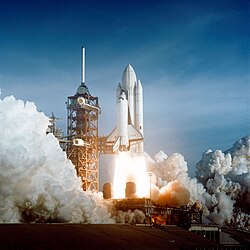STS-54
| Missionsemblem | |||
|---|---|---|---|
 | |||
| Missionsdaten | |||
| Mission | STS-54 | ||
| NSSDCA ID | 1993-003A | ||
| Besatzung | 5 | ||
| Start | 13. Januar 1993, 13:59:30 UTC | ||
| Startplatz | Kennedy Space Center, LC-39B | ||
| Landung | 19. Januar 1993, 13:37:47 UTC | ||
| Landeplatz | Kennedy Space Center, Bahn 33 | ||
| Flugdauer | 5d 23h 38m 17s | ||
| Erdumkreisungen | 96 | ||
| Bahnhöhe | 305 km | ||
| Bahnneigung | 28,45° | ||
| Zurückgelegte Strecke | 4,0 Mio. km | ||
| Nutzlast | TDRS F | ||
| Mannschaftsfoto | |||
 v. l. n. r. Mario Runco, John Casper, Donald McMonagle, Susan Helms, Gregory Harbaugh | |||
| ◄ Vorher / nachher ► | |||
| |||
STS-54 (englisch Space Transportation System) ist eine Missionsbezeichnung für das US-amerikanische Space Shuttle Endeavour (OV-105) der NASA. Der Start erfolgte am 13. Januar 1993. Es war die 53. Space-Shuttle-Mission und der dritte Flug der Raumfähre Endeavour.
Mannschaft
- John Casper (2. Raumflug), Kommandant
- Donald McMonagle (2. Raumflug), Pilot
- Mario Runco (2. Raumflug), Missionsspezialist
- Gregory Harbaugh (2. Raumflug), Missionsspezialist
- Susan Helms (1. Raumflug), Missionsspezialistin
McMonagle und Harbaugh waren bereits bei STS-39 gemeinsam geflogen.
Missionsüberblick
Hauptlast war der fünfte Datenrelaissatellit der TDRS-Reihe (Tracking and Data Relay Satellite), der 6 Stunden und 13 Minuten nach dem Start ausgesetzt wurde. Später brachte ihn eine IUS-Oberstufe (Inertial Upper Stage) auf seine endgültige Umlaufbahn.
Weitere Experimente an Bord waren:
- das Diffuse X-ray Spectrometer (DXS), mit dem Daten über die Röntgenstrahlung diffuser Quellen im Weltall aufgezeichnet wurden;
- der Commercial General Bioprocessing Apparatus (CGPA)
- das Chromosome and Plant Cell Division in Space Experiment (CHROMEX) zum Studium des Pflanzenwachstums;
- das Physiological and Anatomical Rodent Experiment (PARE) zur Untersuchung des Skeletts und dessen Anpassung an die Schwerelosigkeit;
- das Space Acceleration Measurement Equipment (SANS), um die Gravitationskräfte im erdnahen Raum zu messen;
- das Solid Surface Combustion Experiment (SSCE) zur Messung der Ausbreitungsrate und Temperatur von brennendem Filterpapier.
Am fünften Tag der Mission führten Mario Runco und Greg Harbaugh einen fast fünfstündigen Ausstieg in der geöffneten Nutzlastbucht durch, um mehr Erfahrung über das Arbeiten im Weltall zu sammeln. Sie testeten ihre Bewegungsmöglichkeiten, stiegen ohne Hilfe der Hände in Fußhalterungen und simulierten das Tragen von großen Gegenständen.
Siehe auch
Weblinks
- NASA-Missionsüberblick (englisch)
- Videozusammenfassung mit Kommentaren der Besatzung (englisch)
- STS-54 in der Encyclopedia Astronautica (englisch)
Auf dieser Seite verwendete Medien
STS-54 Mission Insignia
The April 12 launch at Pad 39A of STS-1, just seconds past 7 a.m., carries astronauts John Young and Robert Crippen into an Earth orbital mission scheduled to last for 54 hours, ending with unpowered landing at Edwards Air Force Base in California.
Astronauts pictured in the STS-54 crew portrait from left to right are: Mario Runco, Jr., mission specialist; John H. Casper, commander; Donald R. McMonagle, pilot; and mission specialists Susan J. Helms, and Gregory J. Harbaugh. Launched aboard the Space Shuttle Endeavour on January 13, 1993 at 8:59:30 am (EST), the crew deployed the fifth Tracking and Data Relay Satellite (TDRS-6).



